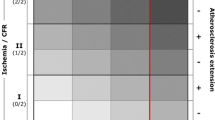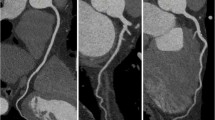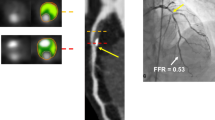Abstract
Coronary artery disease (CAD) diminishes local, regional, or global blood supply to the heart and is most commonly caused by coronary atherosclerosis. New insights into the etiology of atherosclerosis suggest that CAD is an inflammatory disorder that responds well to modulation rather than an unchangeable chronic process. Since 75% of all acute coronary syndromes result from rupture of atherosclerotic plaques, factors causing rupture have a crucial role. Magnetic resonance imaging and CT have the potential to visualize the composition of coronary artery plaques and thus to identify plaques at risk. Considering the new insights into stunning and hibernation, myocardial late enhancement on MRI might provide pivotal information for therapeutic decision making among lysis therapy, catheter intervention, and bypass surgery. Exercise electrocardiography without or with right precordial leads, stress echocardiography, and stress scintigraphy are simple clinical procedures to identify CAD with high sensitivities of 67, 92, 76, and 88%, respectively. The MRI and CT have to be compared with these good results. Nevertheless, we are expecting that MRI and CT will replace the conventional diagnostic modalities, gain a central role in diagnosing patients with suspected CAD, and prove to be cost-effective in this regard.



Similar content being viewed by others
References
Lusis AJ (2000) Atherosclerosis. Nature 407:233–241
Ross R, Glomset JA (1976) The pathogenesis of atherosclerosis (first of two parts). N Engl J Med 295:369–377
Libby P (1995) Molecular bases of the acute coronary syndromes. Circulation 91:2844–2850
van der Wal AC, Das PK, Tigges AJ, Becker AE (1992) Adhesion molecules on the endothelium and mononuclear cells in human atherosclerotic lesions. Am J Pathol 141:1427–1433
Lehr HA, Hubner C, Nolte D et al. (1991) Oxidatively modified human low-density lipoprotein stimulates leukocyte adherence to the microvascular endothelium in vivo. Res Exp Med (Berl) 191:85–90
Cushing SD, Berliner JA, Valente AJ et al. (1990) Minimally modified low-density lipoprotein induces monocyte chemotactic protein 1 in human endothelial cells and smooth muscle cells. Proc Natl Acad Sci USA 87:5134–5138
Stary HC, Chandler AB, Dinsmore RE et al. (1995) A definition of advanced types of atherosclerotic lesions and a histological classification of atherosclerosis. A report from the Committee on Vascular Lesions of the Council on Arteriosclerosis, American Heart Association. Circulation 92:1355–1374
Falk E, Shah PK, Fuster V (1995) Coronary plaque disruption. Circulation 92:657–671
Galis ZS, Muszynski M, Sukhova GK et al. (1994) Cytokine-stimulated human vascular smooth muscle cells synthesize a complement of enzymes required for extracellular matrix digestion. Circ Res 75:181–189
van der Wal AC, Becker AE, van der Loos CM, Das PK (1994) Site of intimal rupture or erosion of thrombosed coronary atherosclerotic plaques is characterized by an inflammatory process irrespective of the dominant plaque morphology. Circulation 89:36–44
Gertz SD, Roberts WC (1990) Hemodynamic shear force in rupture of coronary arterial atherosclerotic plaques. Am J Cardiol 66:1368–1372
Jennings RB, Murry CE, Steenbergen C Jr, Reimer KA (1990) Development of cell injury in sustained acute ischemia. Circulation 82:112
Heyndrickx GR, Millard RW, McRitchie RJ, Maroko PR, Vatner SF (1975) Regional myocardial functional and electrophysiological alterations after brief coronary artery occlusion in conscious dogs. J Clin Invest 56:978–985
Diamond GA, Forrester JS, Luz PL de, Wyatt HL, Swan HJ (1978) Post-extrasystolic potentiation of ischemic myocardium by atrial stimulation. Am Heart J 95:204–209
Shan K, Bick RJ, Poindexter BJ et al. (2000) Altered adrenergic receptor density in myocardial hibernation in humans: a possible mechanism of depressed myocardial function. Circulation 102:2599–2606
Murry CE, Jennings RB, Reimer KA (1986) Preconditioning with ischemia: a delay of lethal cell injury in ischemic myocardium. Circulation 74:1124–1136
Tunstall-Pedoe H, Vanuzzo D, Hobbs M et al. (2000) Estimation of contribution of changes in coronary care to improving survival, event rates, and coronary heart disease mortality across the WHO MONICA Project populations. Lancet 355:688–700
Kopp AF, Schroeder S, Baumbach A et al. (2001) Non-invasive characterisation of coronary lesion morphology and composition by multislice CT: first results in comparison with intracoronary ultrasound. Eur Radiol 11:1607–1611
Buffon A, Biasucci LM, Liuzzo G, D’Onofrio G, Crea F, Maseri A (2002) Widespread coronary inflammation in unstable angina. N Engl J Med 347:5–12
Nieman K, Rensing BJ, van Geuns RJ et al. (2002) Usefulness of multislice computed tomography for detecting obstructive coronary artery disease. Am J Cardiol 89:913–918
Achenbach S, Giesler T, Ropers D et al. (2001) Detection of coronary artery stenoses by contrast-enhanced, retrospectively electrocardiographically gated, multislice spiral computed tomography. Circulation 103:2535–2538
Nieman K, Cademartiri F, Lemos PA, Raaijmakers R, Pattynama PM, de Feyter PJ (2002) Reliable noninvasive coronary angiography with fast submillimeter multislice spiral computed tomography. Circulation 106:2051–2054
Wielopolski PA, van Geuns RJ, de Feyter PJ, Oudkerk M (2000) Coronary arteries. Eur Radiol 10:12–35
Jakobs TF, Becker CR, Ohnesorge B et al. (2002) Multislice helical CT of the heart with retrospective ECG gating: reduction of radiation exposure by ECG-controlled tube current modulation. Eur Radiol 12:1081–1086
Hunink MG, Kuntz KM, Fleischmann KE, Brady TJ (1999) Noninvasive imaging for the diagnosis of coronary artery disease: focusing the development of new diagnostic technology. Ann Intern Med 131:673–680
Sakuma H, Kawada N, Takeda K, Higgins CB (1999) MR measurement of coronary blood flow. J Magn Reson Imaging 10:728–733
Kim RJ, Wu E, Rafael A et al. (2000) The use of contrast-enhanced magnetic resonance imaging to identify reversible myocardial dysfunction. N Engl J Med 343:1445–1453
Diamond GA, Forrester JS (1979) Analysis of probability as an aid in the clinical diagnosis of coronary artery disease. N Engl J Med 300:1350–1358
Richter WS, Munz DL (1997) Nuclear medicine diagnosis in the characterization of atherosclerotic plaques. Dtsch Med Wochenschr 122:761–766 [in German]
Davies MJ (2000) The pathophysiology of acute coronary syndromes. Heart 83:361–366
Acknowledgement
We thank B. Herwig for assistance with preparation of the article.
Author information
Authors and Affiliations
Corresponding author
Rights and permissions
About this article
Cite this article
Dewey, M., Borges, A.C., Kivelitz, D. et al. Coronary artery disease: new insights and their implications for radiology. Eur Radiol 14, 1048–1054 (2004). https://doi.org/10.1007/s00330-003-2175-2
Received:
Revised:
Accepted:
Published:
Issue Date:
DOI: https://doi.org/10.1007/s00330-003-2175-2




